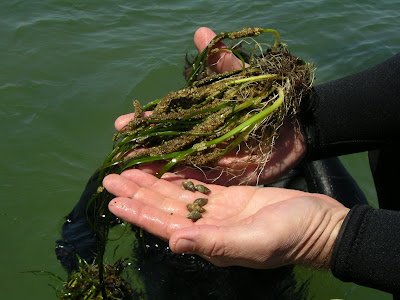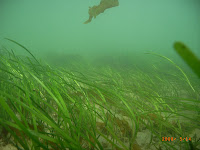
This spring has brought unwelcome visitors to the area. Harmful Algae Blooms! Our old friend and archenemy of eelgrass and shellfish, the “Brown Tide” (Aureococcus anophagefferens), has hit Great South Bay hard and is creeping east at an alarming rate. Another species, nicknamed the “Mahogany Tide” (Prorocentrum minimum) (see photos) has also been sighted in local waters. First time I’ve heard of that one. What is happening?
 Fortunately we are in capable hands as Robert “Mac” Waters, Supervisor for the Suffolk County Department of Health Services, Bureau of Marine Resources has been sending out almost daily email alerts detailing the geographic spread and intensity of the bloom as his team tracks the invasion.
Fortunately we are in capable hands as Robert “Mac” Waters, Supervisor for the Suffolk County Department of Health Services, Bureau of Marine Resources has been sending out almost daily email alerts detailing the geographic spread and intensity of the bloom as his team tracks the invasion.
This has already caused the cancellation of a long overdue NYSDOS-sponsored aerial mapping effort for eelgrass in the SSER where you can’t see the bottom and the Peconics for logistical reasons. In addition, we had planned to follow up on a seeding project we conducted at the Blue Points Property owned by TNC, but this was also scrubbed given the nonexistent vis.
My main concern at this time is two-fold. First, how far into Shinnecock Bay will the BT spread? We have plans to work in western parts of the bay this year, but that will likely be on hold for now. What about the eastern half though? Will it move east of the canal? Also, if it does move into the eastern part of the bay will it pass north through the Shinnecock Canal and into the Peconic Estuary? That would really be a bummer…our Red Cedar Bluff site, that is doing so well, is very close to the canal.
At this point all we can do is sit back and let the SCDHS do their job. Every day we watch the numbers come in like some defeated general getting casualty reports from the field. Hopefully, this will end some time soon. If not, we could lose even more eelgrass.
I’m just glad that BT doesn’t bloom in Long Island Sound….yet!
 Fortunately we are in capable hands as Robert “Mac” Waters, Supervisor for the Suffolk County Department of Health Services, Bureau of Marine Resources has been sending out almost daily email alerts detailing the geographic spread and intensity of the bloom as his team tracks the invasion.
Fortunately we are in capable hands as Robert “Mac” Waters, Supervisor for the Suffolk County Department of Health Services, Bureau of Marine Resources has been sending out almost daily email alerts detailing the geographic spread and intensity of the bloom as his team tracks the invasion.This has already caused the cancellation of a long overdue NYSDOS-sponsored aerial mapping effort for eelgrass in the SSER where you can’t see the bottom and the Peconics for logistical reasons. In addition, we had planned to follow up on a seeding project we conducted at the Blue Points Property owned by TNC, but this was also scrubbed given the nonexistent vis.
My main concern at this time is two-fold. First, how far into Shinnecock Bay will the BT spread? We have plans to work in western parts of the bay this year, but that will likely be on hold for now. What about the eastern half though? Will it move east of the canal? Also, if it does move into the eastern part of the bay will it pass north through the Shinnecock Canal and into the Peconic Estuary? That would really be a bummer…our Red Cedar Bluff site, that is doing so well, is very close to the canal.
At this point all we can do is sit back and let the SCDHS do their job. Every day we watch the numbers come in like some defeated general getting casualty reports from the field. Hopefully, this will end some time soon. If not, we could lose even more eelgrass.
I’m just glad that BT doesn’t bloom in Long Island Sound….yet!
PHOTOS TAKEN BY PHIL DeBLASI, SCDHS
-ChrisP
-ChrisP






































 We were missing many shoots, probably the result of erosion or, more than likely, from crab burrowing. Shoot densities ranged from 20 in the deepest plot to 120 at the second shallowest plot (we planted 200 shoots per plot last fall). Although plot 1 looked the best in the photo (see above) plot 2 actually had the highest density with 120 shoots remaining.
We were missing many shoots, probably the result of erosion or, more than likely, from crab burrowing. Shoot densities ranged from 20 in the deepest plot to 120 at the second shallowest plot (we planted 200 shoots per plot last fall). Although plot 1 looked the best in the photo (see above) plot 2 actually had the highest density with 120 shoots remaining.



 The first transplant work at this site was initiated in 2006 when we established multiple 1m circular plots (perpendicular to shore) across the depth contours to target the most appropriate planting depth. Within the first growing season we lost the two shallowest and one of the deeper plots leaving behind two mid-depth stations. Eventually, the shallower of these also succumbed to disturbance from crabs and was lost.
The first transplant work at this site was initiated in 2006 when we established multiple 1m circular plots (perpendicular to shore) across the depth contours to target the most appropriate planting depth. Within the first growing season we lost the two shallowest and one of the deeper plots leaving behind two mid-depth stations. Eventually, the shallower of these also succumbed to disturbance from crabs and was lost. 





